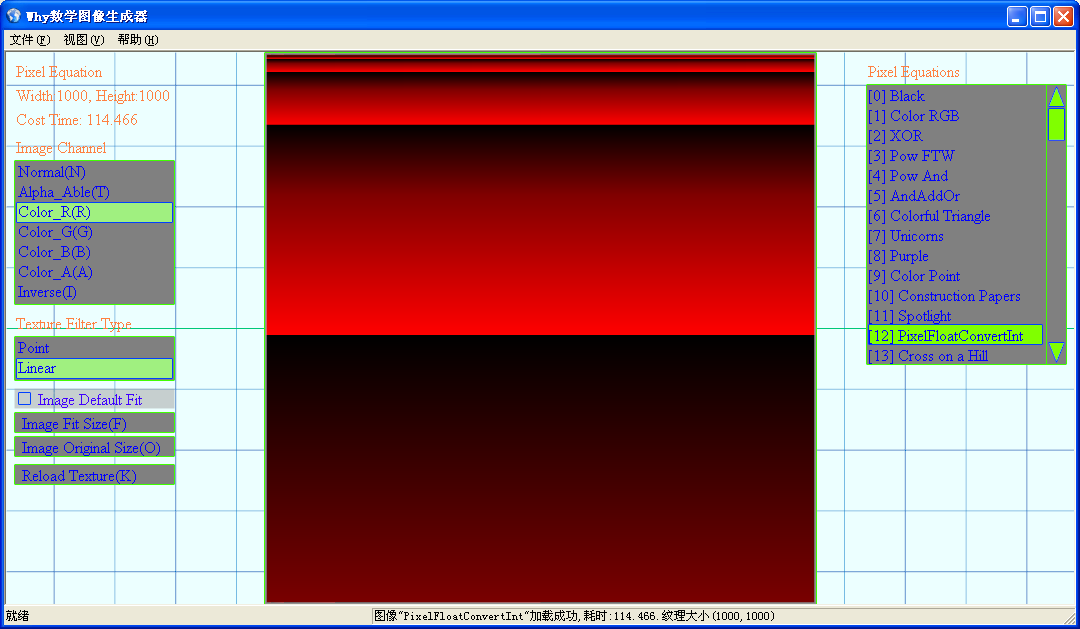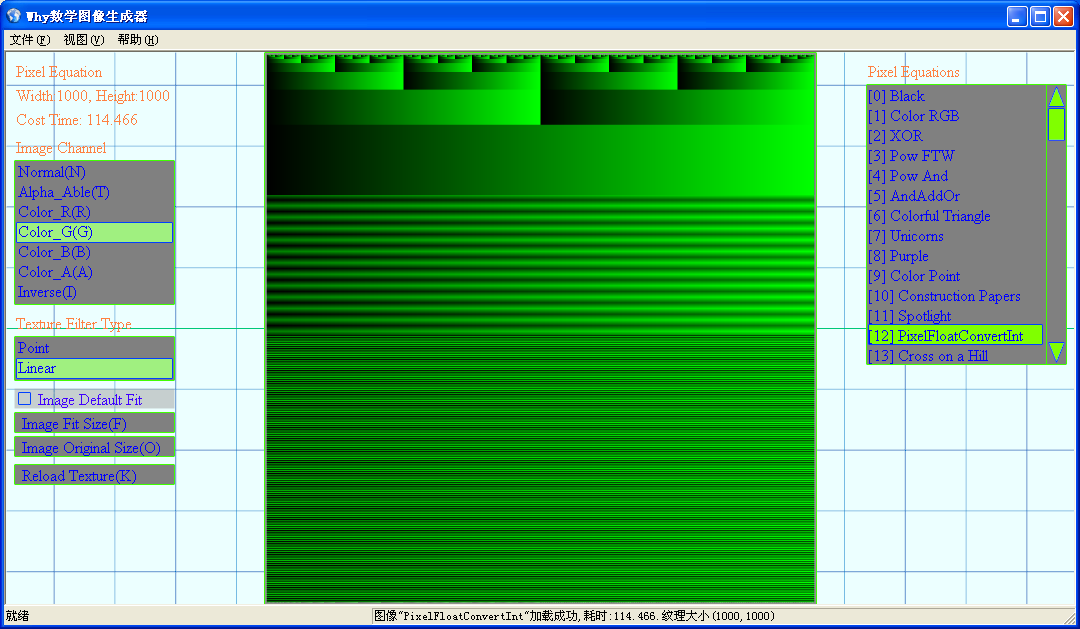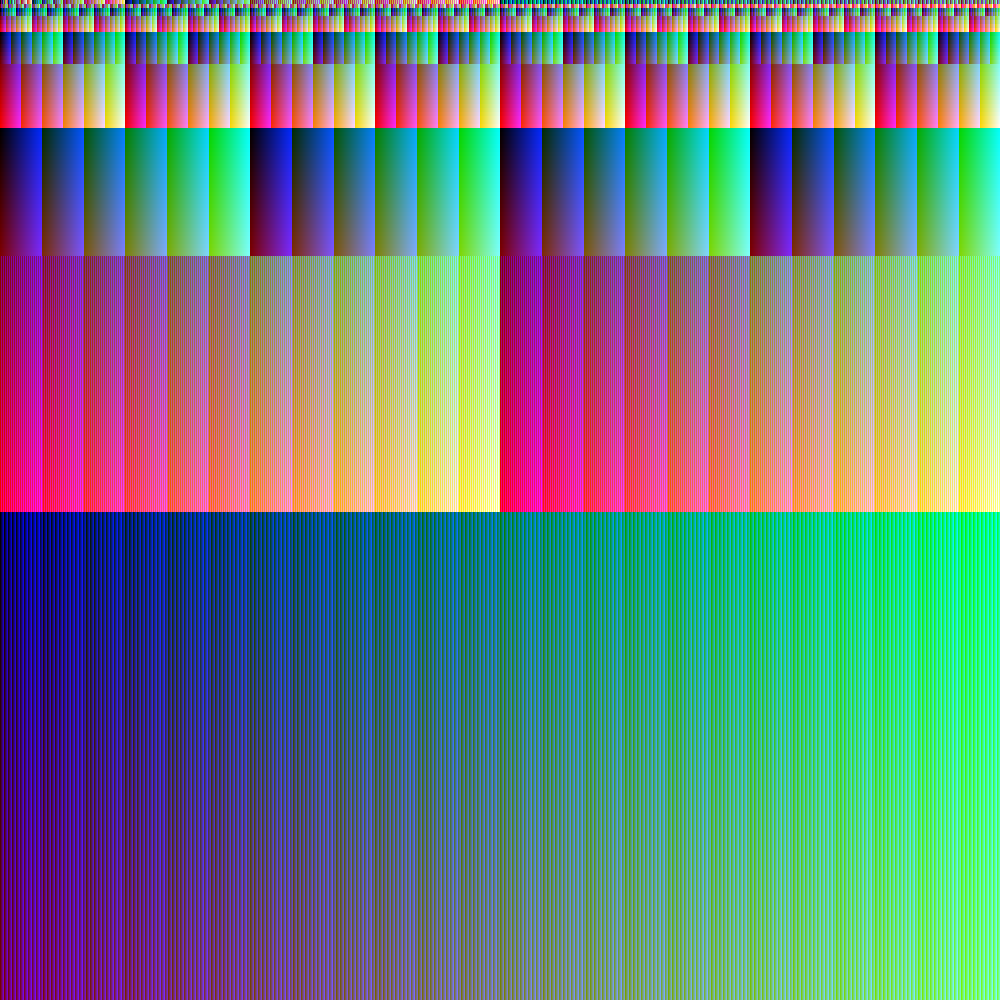C语言中将0到1000的浮点数用强制指针类型转换的方式生成一幅图像
搞过计算机图像的人都知道,图像中的每一个像素通常为一个整型数,它可以分成4个无符号的char类型,以表示其RGBA四个分量。一幅图像可以看做是一个二维整型数组。这里我会生成一个float数组,其数组大小为1000000,刚好1000*1000,数组内的浮点数的数值范围在0到1000.0之间,呈等差数组排列,相邻两数的差为0.001。然后将其每一个浮点数强制转化成一个整型数或三个unsigned char型,以决定像素的RGB三个通道分量,看看其生成的图像是什么样子。
前几天写了一篇文章是在C语言中使用异或运算交换两个任意类型变量,引来某人的质疑,说什么“指针的强制类型转换有一定限制,不是你想怎么转就怎么转的,结果可能会出错的”。用这种莫须有的话来否定我的代码。为嘲笑他的无知,我特意写出这种用强制指针类型转换生成图像的算法。
先上C代码:
#include <iostream>
#include <cmath>
#include <cstdlib>
#define DIM 1000
void pixel_write(int,int);
FILE *fp;
int main()
{
fp = fopen("image.ppm","wb");
if (!fp)
{
return -1;
}
fprintf(fp, "P6\n%d %d\n255\n", DIM, DIM);
for(int j=0;j<DIM;j++)
{
for(int i=0;i<DIM;i++)
{
pixel_write(i,j);
}
}
fclose(fp);
return 0;
}
void pixel_write(int i, int j)
{
static unsigned char color[3];
float t = j + i*0.001f;
memcpy(color, &t, 3);
fwrite(color, 1, 3, fp);
// 其实更简单粗爆的方式是
//fwrite(&t, 1, 3, fp);
}
代码运行后会生成一种PPM格式的图像,如下图所示:

图像多少有点分形的感觉。PPM格式的图像不太常见,它是一种非常简单的图像格式。在我写的软件Why数学图像生成工具中可以查看,当然我也将该图像的生成算法写到这个软件中,相关代码如下:
#ifndef _PixelFloatConvertInt_H_
#define _PixelFloatConvertInt_H_
// --------------------------------------------------------------------------------------
#include "IPixelEquation.h"
// --------------------------------------------------------------------------------------
class CPixelFloatConvertInt : public IPixelEquation
{
public:
CPixelFloatConvertInt()
{
m_width = 1000;
m_height = 1000;
}
const char* GetName() const
{
return "Float Convert Int";
}
unsigned int CalculatePixel(unsigned int x, unsigned int y)
{
float t = y + x*0.001f;
unsigned int rst = *(unsigned int*)&t;
rst |= 0xff000000;
return rst;
}
};
// --------------------------------------------------------------------------------------
#endif
使用Why数学图像生成工具可以查看该图像的红绿蓝三个分量:
R通道图:

G通道图:

B通道图:

代码稍做修改,分形效果更为明显:
unsigned int CalculatePixel(unsigned int x, unsigned int y) { float t = y/4+ x*0.001f; unsigned int rst = *(unsigned int*)&t; rst |= 0xff000000; return rst; }






【推荐】国内首个AI IDE,深度理解中文开发场景,立即下载体验Trae
【推荐】编程新体验,更懂你的AI,立即体验豆包MarsCode编程助手
【推荐】抖音旗下AI助手豆包,你的智能百科全书,全免费不限次数
【推荐】轻量又高性能的 SSH 工具 IShell:AI 加持,快人一步